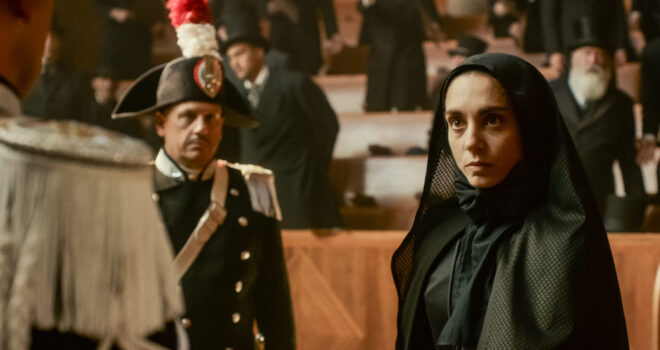Cabrini: Feminist Social Justice Warrior or Catholic Saint?
I rarely go to movies anymore, but last year I saw the teaser trailer for the movie Cabrini that came out on March 8. It was the first time in a while I really wanted to see a movie in theaters. The cinematography looked beautiful and I was excited to see a saint being portrayed […]



I rarely go to movies anymore, but last year I saw the teaser trailer for the movie Cabrini that came out on March 8. It was the first time in a while I really wanted to see a movie in theaters. The cinematography looked beautiful and I was excited to see a saint being portrayed in film with such a wide release. My family and I went to see the movie this past Sunday.
I walked away from the theater after the movie with a deep sense that something was missing from the movie. I told my husband and daughter the movie lacked the “soul” of the matter. There were beautiful and good things about it, but it did not live up to the expectations I saw in the trailer. My enthusiasm had dulled a bit before we went to the movie when I saw a trailer come out featuring Shania Twain’s “Man I Feel Like a Woman”. That song and this holy saint could not be further apart.
The movie is stunning in its cinematography. Reminiscent of A Hidden Life and Of Gods and Men, each scene is a masterpiece of composition, beauty, light, and darkness. It captures the agony of the human condition the Italians faced upon immigrating to the United States in the late 19th Century. A reminder that the melting pot was not always so cohesive. In fact, Catholics know well that this country has a long history of anti-Catholic bigotry, which is one of the main reasons Italians, Irish, Polish, and others did not find a warm welcome when stepping off the boat at Ellis Island.
The film does a phenomenal job of portraying the suffering, poverty, illness, injustice, and difficulties Italians faced in New York City. As is so often the case, politicians and bureaucrats turn a blind eye to the suffering of others because wealth, comfort, poverty, bigotry, and ambition blind them to the plight of the poor. This has always been the case since the Fall, which is why Our Lord calls upon each of His disciples to serve the weak and the vulnerable in our midst, but we are not social justice warriors. We are His disciples on the path to sainthood sent to proclaim the Good News.
I immediately got the sense watching the movie that St. Francis Xavier Cabrini would be turned into the latest feminist social justice warrior in an attempt to evangelize those who subscribe to feminist ideologies. The danger—and it was on display throughout the movie—is to abandon the message of the Gospel in favor or appeasing these ideologies. On more than one occasion Mother Cabrini looked more like a post-modern feminist than a Catholic saint and this seemed intentional. I was surprised because the director and producer of the film are both practicing Catholics.
In a moment that felt petty, and which reminded me of when women refuse to let a man hold the door for them, Mother Cabrini tells Archbishop Corrigan she can carry her own bag when he comes by carriage to meet her after her trip to Rome and offers to help her load her luggage, which is the mark of a gentleman. Portraying a nun in a manner that would disrespect the Archbishop is completely counter to the Catholic sensibilities of the time. She was a woman of profound charity and humility. Archbishop Corrigan became a close friend and advocate of Mother Cabrini, which you wouldn’t know from the film.
Despite the importance of depicting the poverty, corruption, and bigotry of the time, the soul of Mother Cabrini’s work was missing. The Catholic Faith is only implicitly on display throughout the movie and Catholic insiders are the primary ones to pick up on Who truly motivated her. Statues, candles, two scenes in Churches, and one scene of praying grace before meals make up the spiritual dimension of the movie. The Faith seems distant, cold, and flat.
What was most astonishing was how I don’t believe I heard the name of Jesus Christ mentioned once in the movie. Her Spouse was a distant character. If one did not know her background, they would think she was a spiritual justice warrior and feminist in a religious habit. This absence left the movie lacking in a true portray of this incredible Catholic missionary saint.
St. Francis Xavier Cabrini wanted to be a missionary from childhood because her deepest desire was to bring souls to Christ. It was her love of God and the salvation of souls that motivated her every action. She was a woman whose heart belonged to Christ alone. This union allowed her to become a worldwide missionary and spiritual mother. Her life of prayer, the Sacraments, and sacrifice were the nourishment that gave her the strength to persevere against great odds to spread His Good News through schools, orphanages, and hospitals. It was not by her own strength nor by some feminist ideology.
The movie was also devoid of the connection between Christ and the priesthood. While there is no doubt that Mother Cabrini encountered priests who could not fully understand her vision and mission from God, as well as some who were deeply corrupted, the reality is that she had multiple priests and bishops helping her every step of the way. She relied on them for spiritual guidance and the Sacraments. One would think that Mother Cabrini’s sole aim was to take on male dominated institutions like the priesthood or political offices of the day.
While male dominated systems have specific sinful tendencies–thanks to the Fall–and priests can get in the way of God’s will if they are not seeking through prayer to follow His will rather than their own, Mother Cabrini was completely obedient to Holy Mother Church and the hierarchy. She would at times have to convince priests and bishops to go along with her work, but she surrendered anything blocking her way to the Lord and waited on Him to change hearts, which He frequently did for her. Not once do we see Mother Cabrini turn to the Lord in prayerful surrender when encountering a roadblock. She sits up a lot, but there is no explicit movement of prayer. Instead, it’s Mother Cabrini taking on the world on her own.
In a scene near the end of the movie, when she is sitting the chapel where Our Lord is present in the Tabernacle, there is not a single movement of prayer. The movie constantly leaves everything up to her. The very soul of Mother Cabrini’s work was in her union with the Sacred Heart of Jesus. He was her everything, her guide, her motivation, and her strength. What a beautiful scene this could have been had she turned to Her Divine Spouse in the Tabernacle in prayer.
The Cabrini movie is worth seeing, if anything, because it is beautifully filmed and it reveals the sufferings of so many. It serves as a reminder to us, however, that Catholic saints do not fit into post-modern ideological boxes. They transcend them because these are souls who are completely free in Christ. Their work is ultimately His, which is why it mystifies non-believers. As other Catholic reviewers have said, the film has many good qualities, but there needed to be much more explicit references to God in order to do justice to St. Francis Xavier Cabrini’s life. Let us hope that any future projects depicting Catholic saints explicitly portray their love and faith in Christ and His Catholic Church.
Image Credit: Angel Studios














